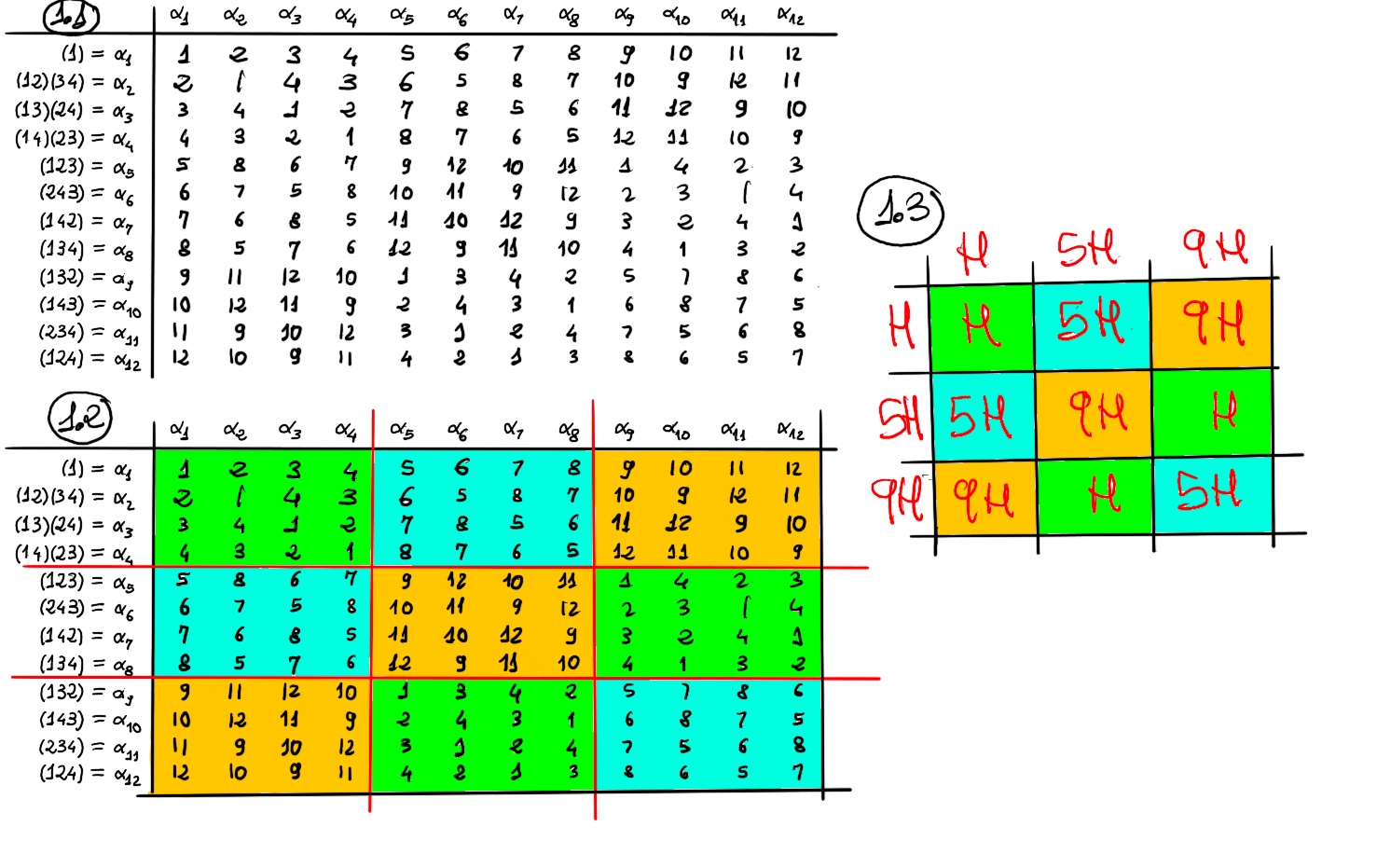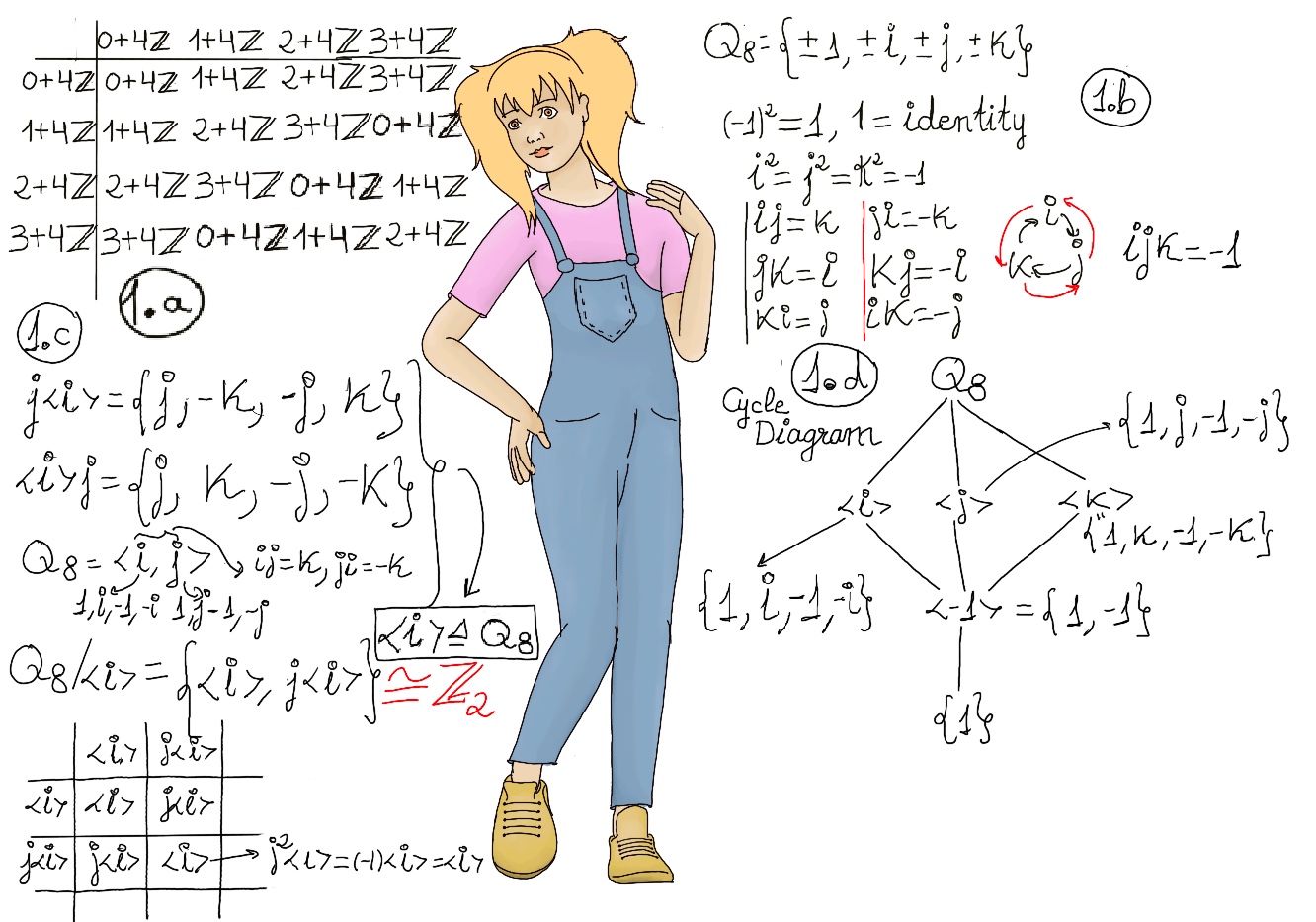
|
 |
 |

|
 |
 |
“Some drink at the fountain of knowledge. Others just gargle. You are just a moron stuck to a nose,” I retorted, but my imagination kept running wild, “You do not have a nose, a superlative muzzle owns you, a crooked sundial casting a disproportionate shadow, an elephant dying a terrible death, face up, gasping from breath; the Great Pyramid of Giza or more accurate, all Egyptian pyramids pile together; the king of swordfish, an insult to nature, and a joke to many,” Anawim, Apocalypse, #justtothepoint.
Definition. A subgroup H of a group G, H ≤ G, is called a normal subgroup of G if aH = Ha, ∀a ∈ G. That is, a normal subgroup of a group G is one in which the right and left cosets are precisely the same. The usual notation for this relation is H ◁ G. It means ∀a ∈ G, h ∈ H, ∃h’, h’’∈ H: ah = h’a and ha = ah’’.
Normal Subgroup Test or alternative definition. A subgroup H of a group G is normal in G if and only if is invariant under conjugation by members of the group G. H ◁ G iff gHg-1 ⊆ H, ∀g ∈ G, i.e., ∀g ∈ G, h ∈ H, ghg-1 ∈ H.

| + | H = {0, 4} | 1 + H = {1, 5} | 2 + H = {2, 6} | 3 + H = {3, 7} |
|---|---|---|---|---|
| H | H | 1 + H | 2 + H | 3 + H |
| 1 + H | 1 + H | 2 + H | 3 + H | H |
| 2 + H | 2 + H | 3 + H | H | 1 + H |
| 3 + H | 3 + H | H | 1 + H | 2 + H |
To calculate (2 + H) + (3 + H), let’s take two representatives 2 + 7 = 9 =mod 8 1 ∈ 1 + H ⇒ (2 + H) + (3 + H) = 1 + H. There are only two groups of order 4, namely ℤ4 (cyclic) and ℤ2 x ℤ2. Besides,
Some calculations: (1, 3) + (1, 3) = (2, 6mod 4) = (2, 2); 3·(1, 3) = (3, 1); 4·(1, 3) = (0, 0) ⇒ H = ⟨(1, 3)⟩ = {(0, 0), (1, 3), (2, 2), (3, 1)}.
Let’s add cosets, e.g., (0, 2) + ⟨(1, 3)⟩ + (0, 1) + ⟨(1, 3)⟩ =[Let’s select two representatives] (0, 2) + (0, 1) + ⟨(1, 3)⟩ = (0, 3) + ⟨(1, 3)⟩
| (0, 0) + ⟨(1, 3)⟩ | (0, 1) + ⟨(1, 3)⟩ | (0, 2) + ⟨(1, 3)⟩ | (0, 3) + ⟨(1, 3)⟩ | |
|---|---|---|---|---|
| (0, 0) + ⟨(1, 3)⟩ | (0, 0) + ⟨(1, 3)⟩ | (0, 1) + ⟨(1, 3)⟩ | (0, 2) + ⟨(1, 3)⟩ | (0, 3) + ⟨(1, 3)⟩ |
| (0, 1) + ⟨(1, 3)⟩ | (0, 1) + ⟨(1, 3)⟩ | (0, 2) + ⟨(1, 3)⟩ | (0, 3) + ⟨(1, 3)⟩ | (0, 0) + ⟨(1, 3)⟩ |
| (0, 2) + ⟨(1, 3)⟩ | (0, 2) + ⟨(1, 3)⟩ | (0, 3) + ⟨(1, 3)⟩ | (0, 0) + ⟨(1, 3)⟩ | (0, 1) + ⟨(1, 3)⟩ |
| (0, 3) + ⟨(1, 3)⟩ | (0, 3) + ⟨(1, 3)⟩ | (0, 2) + ⟨(1, 3)⟩ | (0, 1) + ⟨(1, 3)⟩ | (0, 0) + ⟨(1, 3)⟩ |
Futhermore, the coset |(0, 1) + ⟨(1, 3)⟩| = 4 ⇒ ℤ4 x ℤ4/⟨(1, 3)⟩ = {⟨(1, 3)⟩, (0, 1) + ⟨(1, 3)⟩, (0, 2) + ⟨(1, 3)⟩, (0, 3) + ⟨(1, 3)⟩} ≋ ℤ4
(x, y) + H = (v, w) + H ↭ (x, y) - (v, w) = (x - v, y -w) ∈ H ↭ x = v ⇒[Each coset contains a unique element (x, 0) where x ∈ ℤ4)] G/H = {H, (1, 0) + H, (2, 0) + H, (3, 0) + H}. G/H = {H, (1, 0) + H, (2, 0) + H, (3, 0) + H} ≋ ℤ4 because there is an isomorphism Φ: ℤ4 → G/H, x → (x, 0) + H or, alternatively, we can easily check that |(1, 0) + H | = 4, then G/H = ⟨(1, 0) + H⟩
The cosets of H are: H; 5H = {α5, α6, α7, α8}, α5α1 = α5; α5α2 = (123)(12)(34) = (134) = α8; α5α3 = (123)(13)(24) = (243) = α6; α5α4 = (123)(14)(23) = (142) = α7. Analogously, 9H = {α9, α10, α11, α12}. Example: (α5α1)·(α9α1) = (123)()(132)() = () ⇒ 5H·9H = H, (α5α1)·(α5α1) = (123)()(123)() = (132)() ⇒ 5H·5H = 9H, and so on.
We normally use e = () for simplicity’s sake. (α5α2)·(α9α3) = (123)(12)(34)(132)(13)(24) = (12)(34) = α2 ⇒ 5H·9H = H

2N = {2·1mod 9, 2·8mod 9} = {2, 16mod 9} = {2, 7}, 4N = {4·1mod 9, 4·8mod 9} = {4, 32mod 9} = {4, 5}, 2·5 = 10mod 9 = 1 ⇒ 2N·4N = N.
| 1 | 8 | 2 | 7 | 4 | 5 | |
|---|---|---|---|---|---|---|
| 1 | 1 | 8 | 2 | 7 | 4 | 5 |
| 8 | 8 | 1 | 7 | 2 | 5 | 4 |
| 2 | 2 | 7 | 4 | 5 | 8 | 1 |
| 7 | 7 | 2 | 5 | 4 | 1 | 8 |
| 4 | 4 | 5 | 8 | 1 | 7 | 2 |
| 5 | 5 | 4 | 1 | 8 | 2 | 7 |
| N = {1, 8} | 2N = {2, 7} | 4N = {4, 5} | |
|---|---|---|---|
| N | N | 2N | 4N |
| 2N | 2N | 4N | N |
| 4N | 4N | N | 2N |
3H = {3·1mod 20, 3·19mod 20} = {3, 57mod 20} = {3, 17}, 7N = {7·1mod 20, 7·19mod 20} = {7, 133mod 20} = {7, 13}, 3·7 = 21mod 20 = 1 ⇒ 3H·7H = H.
| H = {1, 19} | 3H = {3, 17} | 7H = {7, 13} | 9H = {9, 11} | |
|---|---|---|---|---|
| H = {1, 19} | H | 3H | 7H | 9H |
| 3H = {3, 17} | 3H | 9H | H | 7H |
| 7H = {7, 13} | 7H | H | 9H | 3H |
| 9H = {9, 11} | 9H | 7H | 3H | H |
|3H| = 4 ⇒ U(20)/H = ⟨3H⟩ ≋ ℤ4
7·7 = 49 =30 19 ⇒ (7H)2 = 11H = {11, 19}. 7·7·7 = 343 =30 13 ⇒ (7H)3 = 13H. 7·7·7·7 = 2401 =30 1 ⇒ (7H)4 = H ⇒ |7H| = 4 ⇒ G/H = ⟨7H⟩ ⇒ G/H ≋ ℤ4
| H | 7H | 11H | 13H | |
|---|---|---|---|---|
| H | H | 7H | 11H | 13H |
| 7H | 7H | 11H | 13H | H |
| 11H | 11H | 13H | H | 7H |
| 13H | 13H | H | 7H | 11H |
G/H = {1H, 3H, 5H, 7H, 9H, 11H, 13H, 15H} where 1H = {1, 17}, 3H = {3·1, 3·17 = 51mod 32 19} = {3, 19}, 5H = {5·1, 5·17 = 85mod 32 21} = {5, 21}, 7H = {7, 23}, 9H = {9, 25}, 11H = {11, 27}, 13H = {13, 29}, 15H = {15, 31}
(3H)2 = (3H)·(3H) = 9H ≠ H, (3H)4 = H (3·3·3·3 = 81 = 17 (mod 32)) ⇒ |3H| = 4 and ℤ2 ⊕ ℤ2 ⊕ ℤ2 has no elements of order 4 ⇒ G/H ≇ ℤ2 ⊕ ℤ2 ⊕ ℤ2. Since |7H| = |9H| = 2 (7·7 = 49mod 32 = 17, 9·9 = 81mod 32 = 17) ⇒ G/H has at least two elements of order 2, but ℤ8 has only one element of order 2, namely 4 ⇒ G/H ≇ ℤ8, hence G/H ≋ ℤ4 ⊕ ℤ2
Which of the three Abelian groups of order eight is it? (3K)2 = 9K, (3K)3 =[3·3·3mod 43 = 27] = 21K. (3K)4 =[27*3 = 81mod 32 = 17] 17K ≠ K ⇒[|G/K| = 8, and so by Lagrange Theorem, the only options are 1, 2, 4 and 8] |3K| = 8 ⇒[G/K is cyclic] G/K ≋ ℤ8.
Let’s see the cosets of the group, Q8/⟨i⟩ = {⟨i⟩, j⟨i⟩}. Notice that ⟨i⟩ is the identity of the quotient group. The Cayley table for Q8/⟨i⟩ is exactly equal as ℤ2, and therefore Q8/⟨i⟩ ≋ ℤ2. The same applies with ⟨j⟩ and ⟨k⟩. Figures 1.c. and 1.d.

Q8/⟨-1⟩ = {⟨-1⟩, i⟨-1⟩, j⟨-1⟩, k⟨-1⟩} and all elements of this group has order 2 except obviously the identity, that’s why Q8/⟨-1⟩ is isomorphic to ℤ2 x ℤ2.
⟨-1⟩ = {-1, 1}, i⟨-1⟩ = {-i, i}, i⟨-1⟩i⟨-1⟩ = i2⟨-1⟩ = -1⟨-1⟩ =[-1 ∈ ⟨-1⟩] ⟨-1⟩
The isomorphism Q8/⟨-1⟩ → ℤ2 x ℤ2, is defined by ⟨-1⟩ → (0, 0), i⟨-1⟩ → (1, 0), j⟨-1⟩ → (0, 1), k⟨-1⟩ → (1, 1).
Let’s suppose H ≤ G, |H| = 6, then |A4/H| = 12/2 = 2 ⇒ [Let H ≤ G be any subgroup of a finite group G. If |G/H| = |G|/|H|=2 then H ◁ G.] H ◁ G.
|H| = 6, so there are some 3-cycle (there are 8 3-cycles) that are not in H. Let x be a 3-cycle that is not in H, and consider the cosets H, xH, and x2H in A4/H -x3H =[x is a 3-cycle] eH = H-. Since this is a group of order 2, two of the cosets must be equal. However, H and xH are distinct by construction (x ∉ H ↭ xH ≠ H), so we have two options:
Theorem. Let G be a group, and let be Z(G) the center of G. If G/Z(G) is cyclic, then G is Abelian.
Proof:
Let gZ(G) be a generator of the cyclic group G/Z(G), ⟨gZ(G)⟩ = G/Z(G)
∀a, b ∈ G, ∃i, j ∈ ℤ: aZ(G) = (gZ(G))i = [(aH)(bH)=abH by definition] giZ(G), and bZ(G) = (gZ(G))j = [(aH)(bH)=abH by definition] gjZ(G)
aZ(G) = giZ(G), bZ(G) = gjZ(G) ⇒ [A left (or right) coset is uniquely determined or represented by any one of its elements, i.e., aH = bH iff a ∈ bH] a ∈ giZ(G), b ∈ gjZ(G) ⇒ ∃ x, y ∈ Z(G): a = gix, b = gjy
ab = (gix)(gjy) =[Associativity] gi(xgj)y [x ∈ Z(G) ⇒ xgj = gjx] gi(gjx)y = (gigj)(xy) =[Trivial exponential rules] (gjgi)(xy) =[x ∈ Z(G)] (gjgi)(yx) = gj(giy)x =[y ∈ Z(G)] (gjy)(gix) = ba ∎
Corollary 1: If G/H is cyclic, H ≤ Z(G) ⇒ G is Abelian.
Proof.
H ≤ Z(G), G/H cyclic ⇒[Claim 🔑] G/Z(G) cyclic ⇒[By the previous theorem] G is Abelian.
Claim 🔑: H ≤ Z(G), G/H cyclic ⇒ G/Z(G) cyclic.
G/H cyclic ⇒ G/H = ⟨aH⟩ ⇒ ∀g ∈ G, ∃n ∈ ℤ: gH = (aH)n = anH ↭[aH = bH ↭ b-1a ∈ H] g-1an ∈ H ≤ Z(G) ⇒ g-1an ∈ Z(G) ↭ gZ(G) = anZ(G) = (aZ(G))n, so aZ(G) is a generator or G/Z(G)∎
Corollary 2: If G is non-Abelian, then G/Z(G) is not cyclic.
Corollary 3: Let G be a non-Abelian group, |G| = pq, where p and q are primes, then G must have a trivial center.
Proof: Let G be a non-Abelian group ⇒ G/Z(G) is not cyclic.
Z(G) is a normal subgroup of G (Z(G) ◁ G) ⇒[|Z(G)| divides |G| = p·q, p and q are primes] |Z(G)| = 1, p, q or pq.
G is not Abelian ⇒ |Z(G)| ≠ pq. If |Z(G)| = p or q, then |G/Z(G)| is either q or p. Since p and q are primes ⇒ [Every group of prime order is cyclic.] G/Z(G) is a cyclic group ⊥ (G is non-Abelian group, Corollary 2). Therefore, |Z(G)| = 1, G has a trivial center∎
A group of prime order is always cyclic. Let G be a non-trivial group, where |G| is prime. In other words, it has an element g ≠ e, |g| ≠ 1, |g| divides |G| prime ⇒ |g| = |G|, and therefore, G = ⟨g⟩.